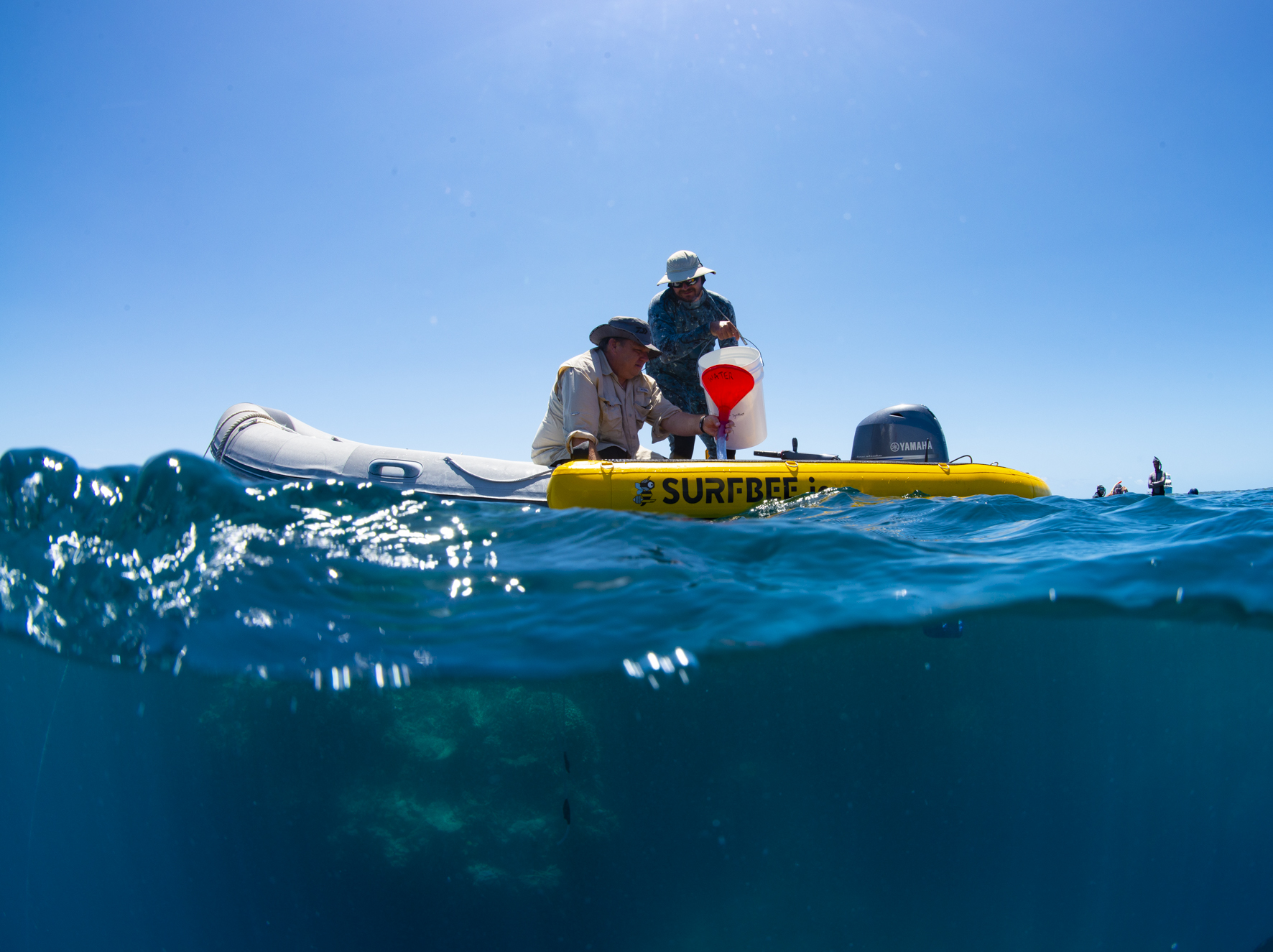
Coral experts have scaled up their advanced technological approach to restoring baby corals on damaged areas of the Great Barrier Reef, using large inflatable 'coral nurseries' to help grow coral babies and a robotic 'LarvalBoat' to help disperse them back onto damaged sections of reef.
Project leader Southern Cross University Professor Peter Harrison has partnered with QUT Professor Matthew Dunbabin for a second year, using a scaled up QUT robotic design to help distribute the vital coral babies at Moore Reef off Cairns. It follows the successful trial of the world-first robotic coral delivery system last year, and larger hectare scale delivery on reefs in the Philippines earlier this year.
Researchers from Southern Cross University, JCU, QUT, and UTS worked with reef tourism partners Reef Magic and Aroona Boat Charters to collect many millions of coral eggs and sperm from the reef during last week's spectacular annual mass coral spawning events on the Great Barrier Reef, using Professor Harrison's spawn catcher and floating nursery pool systems to grow the coral larvae.
Professor Harrison pioneered the coral larval restoration technique (known as coral IVF), and says this week the team has settled millions of coral babies back onto the reef, with coral polyps already starting to grow.
"The larval restoration technique involves capturing spawn from thermally tolerant corals that have survived mass bleaching devastation, and rearing millions of larvae in floating nursery pools so they don't float away before they are capable of settling on the reef," Professor Harrison said.
"We're excited to have successfully released millions of coral larvae back onto the reef using methods including QUT's LarvalBoat, and dispersing large-scale larval clouds from nets onto damaged sections of the reef. But it's important everyone understands that restoration alone cannot save these beautiful complex reef ecosystems. Urgent action on climate change is required to ensure their survival."
The robotic fleet delivering coral larvae
This year Professor Dunbabin's robot fleet included two new LarvalBots and, for the first time, an inflatable LarvalBoat which carries a large volume of coral larvae at the water surface for targeted dispersal on the damaged reef areas, thereby increasing the efficiency of the larval supply.
"In the year since the first LarvalBot trial, we've been able to extend the reach of the robot's larval delivery system from 500 square metres to a recent trial in the Philippines where a LarvalBot was able to cover an area of three hectares of degraded reef in six hours," said Professor Dunbabin.
The approach of combining coral ecology and robot technology is generating excitement from reef researchers working on other damaged reefs including in the Caribbean and Indonesia.
"We are expanding the LarvalBot fleet which can be fitted with a range of payloads. We've had significant interest from around the world to use LarvalBots to spread coral larvae where it's most needed, and we've designed the new LarvalBoat inflatable system so in future they can be fitted in backpacks and the two can be transported and used together," Professor Dunbabin said.
Professor Harrison said the collaboration with QUT, funded by the Great Barrier Reef Foundation with support from The Tiffany & Co. Foundation, could "revolutionise coral restoration on reefs worldwide, restoring damaged reef systems and speeding up the recovery of these spectacular ecosystems."
Aside from being fitted out with a coral delivery system, the original 'RangerBot' can also have a water quality monitoring system attached and can be used to identify and locate the Crown of Thorns starfish.

Plans to bring Coral IVF to citizen scientists
The discovery of mass coral spawning (which occurs at night after the full moon in late spring or early summer) not only earned Professor Harrison and colleagues a prestigious Eureka Prize for Environmental Research in the 1980s, but sparked his idea about how corals could be restored on a mass scale using millions of larvae following a catastrophic bleaching event.
For the past seven years Professor Harrison has been successfully developing the 'Coral IVF' method, collecting coral spawn released during the 'underwater snowstorm', growing millions of coral larvae in enclosures before releasing coral babies to stimulate the recovery of degraded coral reefs.
Now, he plans to increase impact both globally and locally here on the Great Barrier Reef. The new inflatable coral spawn catcher and rearer pool designs can also be folded into large backpacks. There is potential for these kits to be used by members of the public acting as 'citizen scientists' to grow their own larvae and implant back onto the reef.
"We could have dozens or even hundreds of these integrated spawn catcher larval rearer pools being used on the reef by citizen scientists in the near future," said Professor Harrison.
- Download images
- All VNR (spawning, project footage, other interviews): https://biopixel.tv/tv-news-broadcasters-use/






